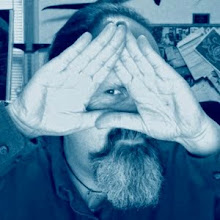In the political arena, the role of the mainstream media is playing an ever-decreasing role, due to the large amount of information online-- whether you lean to the left or the right or to another direction altogether, you'll find a ton of information that is right up your alley. The political action on the blogosphere and other Internet political sites has simply exploded. No longer are people forced to rely on the mainstream media outlets for their news and political information.
In like manner, artists are no longer limited to the mainstream art magazines, such as Art in America, Artforum, etc. The periodical market has seen the rise of alternative art mags like Juxtapoz and New American Paintings, both of which I highly recommend. But again, as in politics, in the world of new and alternative art, the Internet is where the action is.
Anyone who has read this blog to any extent knows that my taste in art is pretty eclectic. In recent years, as I have more or less left the world of commercial illustration behind (my former career), I have been digging increasingly deeper into a wide range of different types of art. One of my favorite artists is the visionary/surrealist painter Abdul Mati Klarwein. I had the good fortune to be introduced to his work in the 1970s, and have previously featured him on this blog (click here to go to that page). Through looking at Klarwein's work on the Internet, and then following one link after another, I have discovered that there is a significant art movement that exists more or less underground-- this movement (for lack of a better term) is generally referred to as visionary art. I have fallen down the rabbit hole.

Klarwein, Astral Body Awake, 1969
Visionary art is actually a fairly broad term; visionary artists find inspiration in a number of ways-- from dreams, meditation, religious/spiritual experience, and sometimes through the use of what are referred to as entheogens, "psychoactive substances used in a religious or shamanic context" (as referred to by wikipedia). Visionary art has been around since humans first started creating images, some 30,000 years ago (much of this art [cave paintings, petroglyphs, etc.] is considered to have possibly been inspired by shamanic visions and/or the use of phychoactive plants). More recent visionary artists include Hieronymous Bosch (15/16c.), William Blake (18/19c.), and in the twentieth century, Salvador Dali and Frida Kahlo.
Back to Klarwein... Klarwein's work has led me to an increasingly large number of artists working within the field of visionary art. Two of these artists have already been featured on this blog-- A. Andrew Gonzalez, and Luke Brown. I would now like to feature an introduction to the work of two very influential artists, Ernst Fuchs, and Alex Grey.
You will probably not see either of these artists in the pages of Art in America, but you might see them in Juxtapoz, and both have a significant presence on the Internet. Of the two, Grey, an American artist (1953-) is probably more well known in the U.S. There are a number of books of his art that are readily available, and he has also written an excellent book about his philosophy of art, The Mission of Art .

(click on image to zoom in)
Note: On his website, Grey is very specific about not reproducing his art without permission, so if you would like to see his art, follow the link below near the bottom of this post.

Ernst Fuchs
Fuchs (1930-) is, in a sense, the grand master of contemporary visionary art-- Klarwein and a number of other visionary painters such as Robert Venosa and Philip Rubinov-Jacobson have studied with Fuchs. Unfortunately, however, Fuchs, who is Austrian, has apparently not yet been discovered by any American publishers-- there is virtually nothing of his work in any books that are readily available in English. Happily, however, he has an extensive personal website, where you can see a wide range of his work. Grey also has an excellent and very comprehensive website. (I have recently learned, by the way, that Fuchs was featured in Avant Garde magazine in 1969, but look to drop some serious cash if you are looking for a copy.)

Fuchs working, 2000. Photo by L. Caruana

Fuchs with Dali

Crucification and Self-portrait, with Inge Beside the Cross, 1945

The Wedding of the Unicorn, 1952-1960

The Angel of Death Over the Gate to Purgatory, 1951-1956

Moses Before the Burning Bush, 1962
(click on image to zoom in)

The Transfiguration of the Resurrected, 1961-1982
(click on image to zoom in)

The Angel of History, 1992
In a world where the mainstream art world often has little interest in technical skill, the visionary painters typically are highly skilled artists—pretty refreshing, if you ask me.
Do yourself a favor, and check out the work of these two artists in more detail at their personal websites:
Ernst Fuchs, and Alex Grey.
A word of warning: be careful-- you may find yourself tumbling down the rabbit hole of visionary art!






